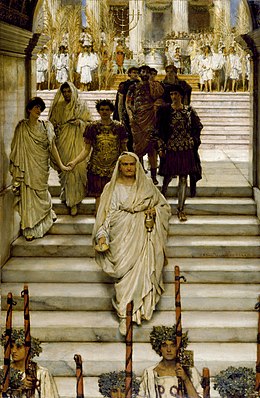Flavians
| Roman imperial dynasties | |||
| Flavian dynasty | |||
 The Flavian family, depicted on The Triumph of Titus, by Sir Lawrence Alma-Tadema |
|||
| Chronology | |||
| Vespasian | 69 AD – 79 AD | ||
| Titus | 79 AD – 81 AD | ||
| Domitian | 81 AD – 96 AD | ||
| Family | |||
|
Gens Flavia Category:Flavian dynasty |
|||
| Succession | |||
|
Preceded by Year of the Four Emperors |
Followed by Nerva–Antonine dynasty |
||
The Flavian dynasty was a Roman imperial dynasty, which ruled the Roman Empire between 69 AD and 96 AD, encompassing the reigns of Vespasian (69–79), and his two sons Titus (79–81) and Domitian (81–96). The Flavians rose to power during the civil war of 69, known as the Year of the Four Emperors. After Galba and Otho died in quick succession, Vitellius became emperor in mid 69. His claim to the throne was quickly challenged by legions stationed in the Eastern provinces, who declared their commander Vespasian emperor in his place. The Second Battle of Bedriacum tilted the balance decisively in favour of the Flavian forces, who entered Rome on December 20. The following day, the Roman Senate officially declared Vespasian emperor of the Roman Empire, thus commencing the Flavian dynasty. Although the dynasty proved to be short-lived, several significant historic, economic and military events took place during their reign.
The reign of Titus was struck by multiple natural disasters, the most severe of which was the eruption of Mount Vesuvius in 79. The surrounding cities of Pompeii and Herculaneum were completely buried under ash and lava. One year later, Rome was struck by fire and a plague. On the military front, the Flavian dynasty witnessed the siege and destruction of Jerusalem by Titus in 70, following the failed Jewish rebellion of 66. Substantial conquests were made in Great Britain under command of Gnaeus Julius Agricola between 77 and 83, while Domitian was unable to procure a decisive victory against King Decebalus in the war against the Dacians. In addition, the Empire strengthened its border defenses by expanding the fortifications along the Limes Germanicus.
...
Wikipedia
